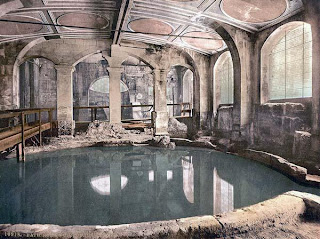The water which bubbles up from the ground at Bath fell as rain on the nearby Mendip Hills. It percolates down through limestone aquifers to a depth of between 2,700 metres (8,900 ft) and 4,300 metres (14,100 ft) where geothermal energy raises the water temperature to between 64 °C (147.2 °F) and 96 °C (204.8 °F). Under pressure, the heated water rises to the surface along fissures and faults in the limestone. This process is similar to an artificial one known as Enhanced Geothermal System which also makes use of the high pressures and temperatures below the Earth's crust. Hot water at a temperature of 46 °C (114.8 °F)rises here at the rate of 1,170,000 litres (257,364 imp gal) every day,[6] from a geological fault (the Pennyquick fault). In 1983 a new spa water bore-hole was sunk, providing a clean and safe supply of spa water for drinking in the Pump Room.[7]
http://en.wikipedia.org/wiki/Roman_Baths_(Bath)
http://www.ecenglish.com/blogs/Cambridge/?p=1903
http://blogs.sundaymercury.net/
http://www.historvius.com/roman-baths-bath-330/
Nourished by Britain's only natural hot springs, Bath is a city shaped by its waters. Today you can visit the magnificent Roman Baths temple or bathe in Bath's warm, mineral-rich waters at Thermae Bath Spa.
http://www.thermaebathspa.com/







No comments:
Post a Comment